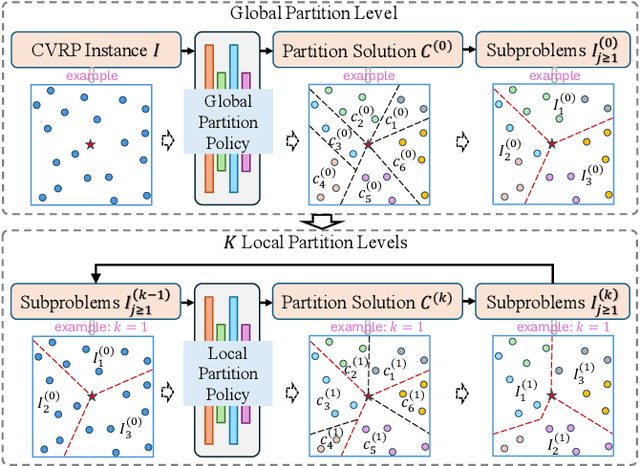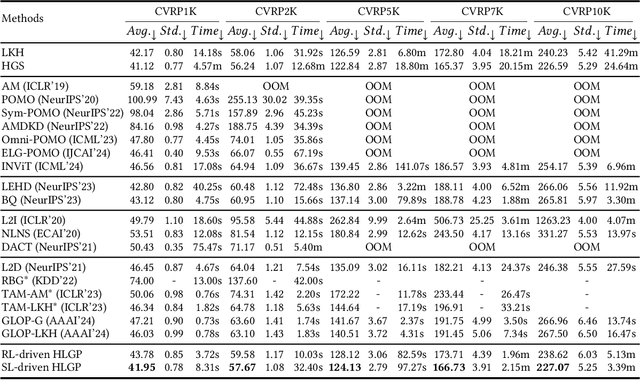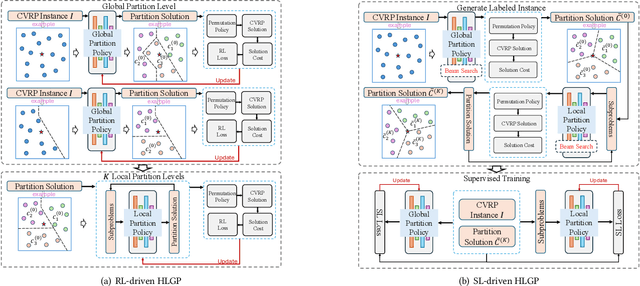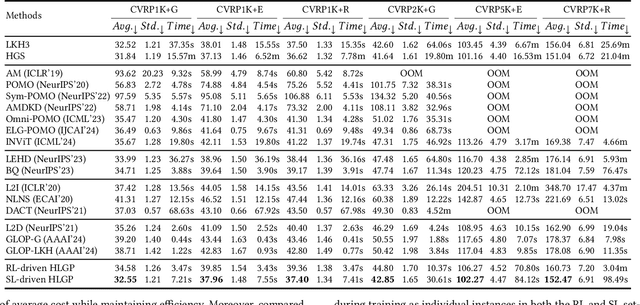Zhiguang Cao
Hybrid-Balance GFlowNet for Solving Vehicle Routing Problems
Oct 06, 2025Abstract:Existing GFlowNet-based methods for vehicle routing problems (VRPs) typically employ Trajectory Balance (TB) to achieve global optimization but often neglect important aspects of local optimization. While Detailed Balance (DB) addresses local optimization more effectively, it alone falls short in solving VRPs, which inherently require holistic trajectory optimization. To address these limitations, we introduce the Hybrid-Balance GFlowNet (HBG) framework, which uniquely integrates TB and DB in a principled and adaptive manner by aligning their intrinsically complementary strengths. Additionally, we propose a specialized inference strategy for depot-centric scenarios like the Capacitated Vehicle Routing Problem (CVRP), leveraging the depot node's greater flexibility in selecting successors. Despite this specialization, HBG maintains broad applicability, extending effectively to problems without explicit depots, such as the Traveling Salesman Problem (TSP). We evaluate HBG by integrating it into two established GFlowNet-based solvers, i.e., AGFN and GFACS, and demonstrate consistent and significant improvements across both CVRP and TSP, underscoring the enhanced solution quality and generalization afforded by our approach.
Instance Generation for Meta-Black-Box Optimization through Latent Space Reverse Engineering
Sep 19, 2025Abstract:To relieve intensive human-expertise required to design optimization algorithms, recent Meta-Black-Box Optimization (MetaBBO) researches leverage generalization strength of meta-learning to train neural network-based algorithm design policies over a predefined training problem set, which automates the adaptability of the low-level optimizers on unseen problem instances. Currently, a common training problem set choice in existing MetaBBOs is well-known benchmark suites CoCo-BBOB. Although such choice facilitates the MetaBBO's development, problem instances in CoCo-BBOB are more or less limited in diversity, raising the risk of overfitting of MetaBBOs, which might further results in poor generalization. In this paper, we propose an instance generation approach, termed as \textbf{LSRE}, which could generate diverse training problem instances for MetaBBOs to learn more generalizable policies. LSRE first trains an autoencoder which maps high-dimensional problem features into a 2-dimensional latent space. Uniform-grid sampling in this latent space leads to hidden representations of problem instances with sufficient diversity. By leveraging a genetic-programming approach to search function formulas with minimal L2-distance to these hidden representations, LSRE reverse engineers a diversified problem set, termed as \textbf{Diverse-BBO}. We validate the effectiveness of LSRE by training various MetaBBOs on Diverse-BBO and observe their generalization performances on either synthetic or realistic scenarios. Extensive experimental results underscore the superiority of Diverse-BBO to existing training set choices in MetaBBOs. Further ablation studies not only demonstrate the effectiveness of design choices in LSRE, but also reveal interesting insights on instance diversity and MetaBBO's generalization.
SHIELD: Multi-task Multi-distribution Vehicle Routing Solver with Sparsity and Hierarchy
Jun 11, 2025Abstract:Recent advances toward foundation models for routing problems have shown great potential of a unified deep model for various VRP variants. However, they overlook the complex real-world customer distributions. In this work, we advance the Multi-Task VRP (MTVRP) setting to the more realistic yet challenging Multi-Task Multi-Distribution VRP (MTMDVRP) setting, and introduce SHIELD, a novel model that leverages both sparsity and hierarchy principles. Building on a deeper decoder architecture, we first incorporate the Mixture-of-Depths (MoD) technique to enforce sparsity. This improves both efficiency and generalization by allowing the model to dynamically select nodes to use or skip each decoder layer, providing the needed capacity to adaptively allocate computation for learning the task/distribution specific and shared representations. We also develop a context-based clustering layer that exploits the presence of hierarchical structures in the problems to produce better local representations. These two designs inductively bias the network to identify key features that are common across tasks and distributions, leading to significantly improved generalization on unseen ones. Our empirical results demonstrate the superiority of our approach over existing methods on 9 real-world maps with 16 VRP variants each.
Learning to Search for Vehicle Routing with Multiple Time Windows
May 29, 2025Abstract:In this study, we propose a reinforcement learning-based adaptive variable neighborhood search (RL-AVNS) method designed for effectively solving the Vehicle Routing Problem with Multiple Time Windows (VRPMTW). Unlike traditional adaptive approaches that rely solely on historical operator performance, our method integrates a reinforcement learning framework to dynamically select neighborhood operators based on real-time solution states and learned experience. We introduce a fitness metric that quantifies customers' temporal flexibility to improve the shaking phase, and employ a transformer-based neural policy network to intelligently guide operator selection during the local search. Extensive computational experiments are conducted on realistic scenarios derived from the replenishment of unmanned vending machines, characterized by multiple clustered replenishment windows. Results demonstrate that RL-AVNS significantly outperforms traditional variable neighborhood search (VNS), adaptive VNS (AVNS), and state-of-the-art learning-based heuristics, achieving substantial improvements in solution quality and computational efficiency across various instance scales and time window complexities. Particularly notable is the algorithm's capability to generalize effectively to problem instances not encountered during training, underscoring its practical utility for complex logistics scenarios.
Meta-Black-Box-Optimization through Offline Q-function Learning
May 04, 2025Abstract:Recent progress in Meta-Black-Box-Optimization (MetaBBO) has demonstrated that using RL to learn a meta-level policy for dynamic algorithm configuration (DAC) over an optimization task distribution could significantly enhance the performance of the low-level BBO algorithm. However, the online learning paradigms in existing works makes the efficiency of MetaBBO problematic. To address this, we propose an offline learning-based MetaBBO framework in this paper, termed Q-Mamba, to attain both effectiveness and efficiency in MetaBBO. Specifically, we first transform DAC task into long-sequence decision process. This allows us further introduce an effective Q-function decomposition mechanism to reduce the learning difficulty within the intricate algorithm configuration space. Under this setting, we propose three novel designs to meta-learn DAC policy from offline data: we first propose a novel collection strategy for constructing offline DAC experiences dataset with balanced exploration and exploitation. We then establish a decomposition-based Q-loss that incorporates conservative Q-learning to promote stable offline learning from the offline dataset. To further improve the offline learning efficiency, we equip our work with a Mamba architecture which helps long-sequence learning effectiveness and efficiency by selective state model and hardware-aware parallel scan respectively. Through extensive benchmarking, we observe that Q-Mamba achieves competitive or even superior performance to prior online/offline baselines, while significantly improving the training efficiency of existing online baselines. We provide sourcecodes of Q-Mamba at https://github.com/MetaEvo/Q-Mamba.
Island-Based Evolutionary Computation with Diverse Surrogates and Adaptive Knowledge Transfer for High-Dimensional Data-Driven Optimization
Mar 17, 2025



Abstract:In recent years, there has been a growing interest in data-driven evolutionary algorithms (DDEAs) employing surrogate models to approximate the objective functions with limited data. However, current DDEAs are primarily designed for lower-dimensional problems and their performance drops significantly when applied to large-scale optimization problems (LSOPs). To address the challenge, this paper proposes an offline DDEA named DSKT-DDEA. DSKT-DDEA leverages multiple islands that utilize different data to establish diverse surrogate models, fostering diverse subpopulations and mitigating the risk of premature convergence. In the intra-island optimization phase, a semi-supervised learning method is devised to fine-tune the surrogates. It not only facilitates data argumentation, but also incorporates the distribution information gathered during the search process to align the surrogates with the evolving local landscapes. Then, in the inter-island knowledge transfer phase, the algorithm incorporates an adaptive strategy that periodically transfers individual information and evaluates the transfer effectiveness in the new environment, facilitating global optimization efficacy. Experimental results demonstrate that our algorithm is competitive with state-of-the-art DDEAs on problems with up to 1000 dimensions, while also exhibiting decent parallelism and scalability. Our DSKT-DDEA is open-source and accessible at: https://github.com/LabGong/DSKT-DDEA.
Adversarial Generative Flow Network for Solving Vehicle Routing Problems
Mar 03, 2025Abstract:Recent research into solving vehicle routing problems (VRPs) has gained significant traction, particularly through the application of deep (reinforcement) learning for end-to-end solution construction. However, many current construction-based neural solvers predominantly utilize Transformer architectures, which can face scalability challenges and struggle to produce diverse solutions. To address these limitations, we introduce a novel framework beyond Transformer-based approaches, i.e., Adversarial Generative Flow Networks (AGFN). This framework integrates the generative flow network (GFlowNet)-a probabilistic model inherently adept at generating diverse solutions (routes)-with a complementary model for discriminating (or evaluating) the solutions. These models are trained alternately in an adversarial manner to improve the overall solution quality, followed by a proposed hybrid decoding method to construct the solution. We apply the AGFN framework to solve the capacitated vehicle routing problem (CVRP) and travelling salesman problem (TSP), and our experimental results demonstrate that AGFN surpasses the popular construction-based neural solvers, showcasing strong generalization capabilities on synthetic and real-world benchmark instances.
Hierarchical Learning-based Graph Partition for Large-scale Vehicle Routing Problems
Feb 12, 2025



Abstract:Neural solvers based on the divide-and-conquer approach for Vehicle Routing Problems (VRPs) in general, and capacitated VRP (CVRP) in particular, integrates the global partition of an instance with local constructions for each subproblem to enhance generalization. However, during the global partition phase, misclusterings within subgraphs have a tendency to progressively compound throughout the multi-step decoding process of the learning-based partition policy. This suboptimal behavior in the global partition phase, in turn, may lead to a dramatic deterioration in the performance of the overall decomposition-based system, despite using optimal local constructions. To address these challenges, we propose a versatile Hierarchical Learning-based Graph Partition (HLGP) framework, which is tailored to benefit the partition of CVRP instances by synergistically integrating global and local partition policies. Specifically, the global partition policy is tasked with creating the coarse multi-way partition to generate the sequence of simpler two-way partition subtasks. These subtasks mark the initiation of the subsequent K local partition levels. At each local partition level, subtasks exclusive for this level are assigned to the local partition policy which benefits from the insensitive local topological features to incrementally alleviate the compounded errors. This framework is versatile in the sense that it optimizes the involved partition policies towards a unified objective harmoniously compatible with both reinforcement learning (RL) and supervised learning (SL). (*Due to the notification of arXiv "The Abstract field cannot be longer than 1,920 characters", the appeared Abstract is shortened. For the full Abstract, please download the Article.)
An Efficient Diffusion-based Non-Autoregressive Solver for Traveling Salesman Problem
Jan 23, 2025



Abstract:Recent advances in neural models have shown considerable promise in solving Traveling Salesman Problems (TSPs) without relying on much hand-crafted engineering. However, while non-autoregressive (NAR) approaches benefit from faster inference through parallelism, they typically deliver solutions of inferior quality compared to autoregressive ones. To enhance the solution quality while maintaining fast inference, we propose DEITSP, a diffusion model with efficient iterations tailored for TSP that operates in a NAR manner. Firstly, we introduce a one-step diffusion model that integrates the controlled discrete noise addition process with self-consistency enhancement, enabling optimal solution prediction through simultaneous denoising of multiple solutions. Secondly, we design a dual-modality graph transformer to bolster the extraction and fusion of features from node and edge modalities, while further accelerating the inference with fewer layers. Thirdly, we develop an efficient iterative strategy that alternates between adding and removing noise to improve exploration compared to previous diffusion methods. Additionally, we devise a scheduling framework to progressively refine the solution space by adjusting noise levels, facilitating a smooth search for optimal solutions. Extensive experiments on real-world and large-scale TSP instances demonstrate that DEITSP performs favorably against existing neural approaches in terms of solution quality, inference latency, and generalization ability. Our code is available at $\href{https://github.com/DEITSP/DEITSP}{https://github.com/DEITSP/DEITSP}$.
DualOpt: A Dual Divide-and-Optimize Algorithm for the Large-scale Traveling Salesman Problem
Jan 15, 2025Abstract:This paper proposes a dual divide-and-optimize algorithm (DualOpt) for solving the large-scale traveling salesman problem (TSP). DualOpt combines two complementary strategies to improve both solution quality and computational efficiency. The first strategy is a grid-based divide-and-conquer procedure that partitions the TSP into smaller sub-problems, solving them in parallel and iteratively refining the solution by merging nodes and partial routes. The process continues until only one grid remains, yielding a high-quality initial solution. The second strategy involves a path-based divide-and-optimize procedure that further optimizes the solution by dividing it into sub-paths, optimizing each using a neural solver, and merging them back to progressively improve the overall solution. Extensive experiments conducted on two groups of TSP benchmark instances, including randomly generated instances with up to 100,000 nodes and real-world datasets from TSPLIB, demonstrate the effectiveness of DualOpt. The proposed DualOpt achieves highly competitive results compared to 10 state-of-the-art algorithms in the literature. In particular, DualOpt achieves an improvement gap up to 1.40% for the largest instance TSP100K with a remarkable 104x speed-up over the leading heuristic solver LKH3. Additionally, DualOpt demonstrates strong generalization on TSPLIB benchmarks, confirming its capability to tackle diverse real-world TSP applications.
 Add to Chrome
Add to Chrome Add to Firefox
Add to Firefox Add to Edge
Add to Edge